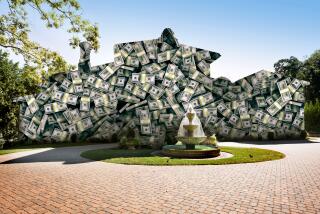Mello-Roos Fees Usually Not Tax Deductible : REALTY TAX TIPS : While property taxes are generally deductible, different rules apply to Mello-Roos levies.
Tens of thousands of Californians, along with millions of Americans, will file federal income tax returns this year containing improper deductions for local property taxes. And they won’t give it a moment’s thought.
That’s because most taxpayers unwittingly take the bottom-line number off their tax bill from the county assessor’s office and assume that this amount can be deducted from gross income.
After all, the Internal Revenue Service rules say that local property taxes are deductible. But examine that bill from the county assessor more closely and you may find so-called Mello-Roos or community facilities district fees tacked on to the basic property tax--amounts that are itemized separately and then included in the final sum.
In California, residents in 236 Mello-Roos districts pay from a few bucks to $6,000 a year or more in special taxes that help finance new roads, libraries, fire stations and schools. According to the California Debt Advisory Commission, $3.6 billion in Mello-Roos bonds had been sold as of 1991, mostly in growing communities in Southern California. And throughout the country, other states have similar special tax districts.
And while local property taxes are deductible, the IRS takes a different view of Mello-Roos levies. However, tax experts believe that the special fees can be deducted in certain cases and advise homeowners to examine their Mello-Roos levies carefully.
“From my perspective, it’s a real problem” said Gary Daniel, a tax preparer in Downey. “Most people think that, after all, Mello-Roos taxes are on your property tax bill, and if it’s on that bill, then it figures that they’re deductible, right? But it’s not as simple as that. The general practice, however, is that most people just look at the bottom-line on their tax bill, and that’s the number that gets used.”
“It’s true,” said Irene Bealer (not her real name), a San Bernardino-based real estate saleswoman. “I’ve taken the deduction for years, and I’ve been telling my clients that it’s okay. Now I’m hoping we aren’t in any trouble.”
Mello-Roos bonds are named after state Sen. Henry J. Mello (D-Watsonville) and former Assemblyman Michael Roos, who won passage of the legislation in 1982. Their goal was to find a way around Proposition 13, the 1978 tax reform initiative.
Under the Mello-Roos Act, local governments get landowners to establish a special tax district. Bonds are then sold to pay for one or more public works projects. The bonds are repaid from the special Mello-Roos tax revenues. While the land within the district is vacant, the landowners or developers pay the Mello-Roos levies. But once developed, new buyers--typically new home purchasers--assume the tax burden.
The addition of Mello-Roos taxes to regular property levies often results in sticker shock. Home buyers must sign disclosure documents indicating that they’ve been informed of the special taxes on their property. But a sense of the total tax liability is often lost in the excitement of the real estate purchase.
To counter negative publicity surrounding Mello-Roos taxes, the Santa Margarita Co., developers of the Rancho Santa Margarita planned community in south Orange County, recently distributed a brochure that defends the special levies. The brochure offers several claims, including this one:
“The California State Treasurer has taken the position that Mello-Roos special taxes are tax deductible. You should consult your tax adviser.”
An aide to state Treasurer Kathleen Brown said Brown has taken no definitive position on Mello-Roos fees, but believes that the levies ought to be deductible.
The IRS, however, takes a contrary view.
“Generally, Mello-Roos taxes are not deductible,” said Judith Golden, spokeswoman for the regional IRS office in Laguna Niguel. “They would have to be based on the value of your property, and could not be used for a project designed to enhance your home or your immediate neighborhood, such as a new street.”
And according to the IRS tax manual:
“Local benefit taxes that are for improvements to property are not deductible. These include assessments for streets, sidewalks, water mains, sewer lines, public parking facilities and similar improvements.”
But here’s where it can get sticky.
The tax code also states that, “Local benefit taxes are deductible if they are for maintenance, repair, or interest charges related to those benefits. If only a part of the taxes is for maintenance, repair or interest, you must be able to show the amount of that part to claim the deduction. If you cannot determine what part of the tax is for maintenance, repair, or interest, none of it is deductible.”
And there are some Mello-Roos taxes used only for maintenance or repair. For example, most homeowners in the Los Alamitos-Seal Beach area pay $50 to $75 a year for school maintenance--not new schools.
“The true answer is that (tax deductibility) depends on the nature of the project,” said John Forman of Newport Beach-based Community Development and Planning Associates. “The general rule is that the more regional the projects are, the more they’re related to the general welfare. But if it’s a road right in front of your house, that’s not going to qualify.”
Bob Williams, a certified public accountant with Kenneth Leventhal & Co., agreed. “It’s a case-by-case thing,” he said. “You have to look at what facilities were financed. A regional library is for the general welfare. I think people would say, ‘Yes, I think it qualifies.’ ”
Williams and tax attorney Joe Hull of the Los Angeles-based law firm of Sheppard, Mullin, Richter & Hampton say there are no tax court cases on the subject. And the IRS says it has no idea how many taxpayers, if any, have been challenged on this type of deduction.
Hull, one of the attorneys who successfully defended Proposition 13 against various legal assaults, suggests following this guideline:
“If a project is for the benefit of the property and enhances its value, then it’s not deductible. The theory of Mello-Roos (levies) is that they are a benefit assessment rather than a tax.”
More to Read
Inside the business of entertainment
The Wide Shot brings you news, analysis and insights on everything from streaming wars to production — and what it all means for the future.
You may occasionally receive promotional content from the Los Angeles Times.










